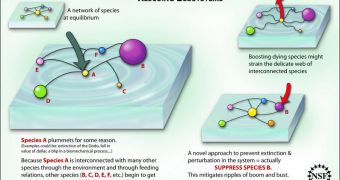Northwestern University physics professor Adilson Motter and his student Sagar Sahasrabudhe announce the development of a new mathematical model, that is capable of detecting potential cascades of events that may lead to the collapse of food networks, and to extinction events.
The model was developed as part of a larger initiative, which seeks to gain new insight into the intricate dynamics that govern complex networks. Examples of such networks include densely-populated ecosystems, food webs and other types of habitats.
What the mathematical simulation does is model the interactions that occur within ecological food webs. This allows it to identify potential rupture points, where prospective damage could severely harm the entire food web.
One of the main uses for the new model is allowing experts and authorities to identify the most relevant points for intervening. Conservation efforts directed at the right links in the food webs can ensure the stability of ecosystems, scientists say.
Details of the new work appear in the January 25 issue of the esteemed scientific journal Nature Communications. “Our study provides a theoretical basis for management efforts that would aim to mitigate extinction cascades in food web networks,” Motter says.
“There is evidence that a significant fraction of all extinctions are caused not by a primary perturbation but instead by the propagation of a cascade,” the expert reveals, adding that such events can usually be seen when a key species in an ecosystem is lost.
Once it is gone, the entire ecosystem and the food webs it contains change to compensate for the loss and all its implications – territory, food and other resources. The niche that develops following the extinction can create population booms for some species, and all the conditions for others to go extinct.
“We find that extinction cascades can often be mitigated by suppressing - rather than enhancing – the populations of specific species,” Motter says.
“In numerous cases, it is predicted that even the proactive removal of a species that would otherwise be extinct by a cascade can prevent the extinction of other species,” he goes on to say.
The scientist admits that this may seem counter-intuitive at first, but adds that the beneficial effects can be seen at the level of the entire ecosystem being conserved.
The development of the new mathematical model was sponsored with grant money secured from the US National Science Foundation's (NSF) Division of Mathematical Sciences (DMS).

 14 DAY TRIAL //
14 DAY TRIAL //